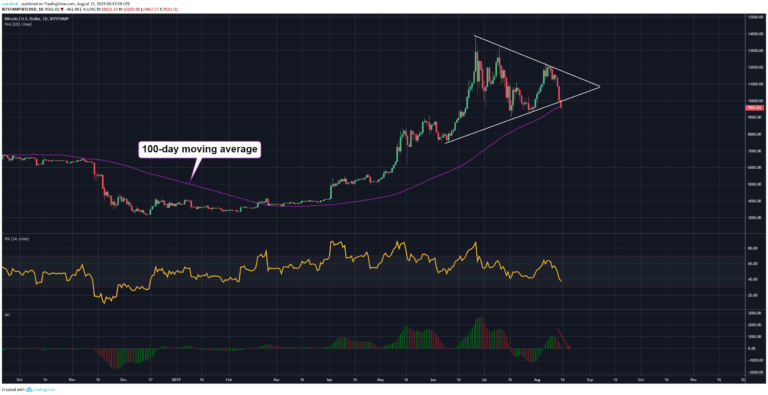The Bears cometh, and the Bears taketh away, from not only equities across the board, but also from Bitcoin and its altcoin brethren, as fears of an impending recession overly sway investor sentiments. That large sucking noise that you hear is the globe’s financial market being drawn into a “Black Hole” of frantic selling. Stocks fell out of bed two days back, some 3%+ on the S&P 500 index, but have slowly pulled back to 3% in active trading today. Bitcoin responded similarly from a timing perspective, but fell $1,800, its greatest one-day drop in a month. It has clawed its way back to $10,400, a good sign.

Source: coindesk.com
The technical storyline is fairly easy to discern from this daily chart, provided courtesy of Coindesk. There are no less than four negative aspects that pop off the chart:
- a string of daily losses in a row;
- a downward break through the “Symmetrical Converging Triangle” formation;
- a falling below the 100-Day Moving Average; and lastly,
- the unfavorable MACD Histogram indicator heading into negative territory.
With so many things going wrong at once, analysts are beginning to talk of more major moves to the south, but the fact that BTC managed to climb back and close over $10,400 is an indication that Bulls have not totally left the trading floor. There have been reports of substantial funds on the sidelines, waiting patiently for bargain prices, as were equity market participants that pushed stocks back to respectable levels today.
Of course, Bitcoin analysts are desperately searching for valid reasons for the sudden fall. The recent narrative had been pushing the notion that investors had finally recognized Bitcoin for its “safe haven” potential, but its reaction today was not in agreement with that recent reasoning. The Yuan did improve, a reason why Chinese investors might switch allegiance, but the volume figures do not line up to support this idea. UK customers of Coinbase may have also been spooked, when Barclay’s dropped the exchange from its client list, but, once again, the volumes are not there.
As a side note, Gold enthusiasts were ecstatic over the recent decline of Bitcoin from “safe haven” glory. Their precious yellow metal held firm, actually appreciating over the same period from $1,500 per ounce to $1,520. Not exactly something to shout about, but it did not lose any of its value during the downdraft. Peter Schiff, a confirmed Gold Bug and Bitcoin skeptic, went so far as to say that Chinese investors were definitely dumping BTC for Yuan and going elsewhere.
Bitcoin dominance has also been surging, of late. Any hint of a pullback sends altcoin hodlers into delirium, dreaming that a long awaited rally, similar to 2017, is just around the corner. According to Noelle Acheson, a veteran of company analysis and CoinDesk’s Director of Research, these times are very different.
As she states in CoinDesk’s website:
Last time the latter stage of the bull market was largely driven by the hyped potential of initial coin offerings, many of which promised revolution and riches based on marketing documents masquerading as white papers. The retail market poured into speculative tokens, which ramped up their value relative to the more “boring” bitcoin – at one stage, it looked like ether was going to push bitcoin off its market leader pedestal.
Bitcoin’s dominance will not last forever, but it may not be changing in the near term, when institutional investors are just beginning to have their presence felt. Acheson notes further:
All trends do eventually tire, to be replaced by new, more energetic ones. The same will happen with bitcoin. Once bitcoin investment by institutions is not such a novelty, and once deeper liquidity has dampened volatility, aggressive managers eager to beat their peers’ performance are going to start thinking about where to find alpha.
Lastly, on both a positive and negative note, analysts remain stuck on the fact that CME futures contracts show two gaps on its chart. Historically, Bitcoin has always filled these gaps.
